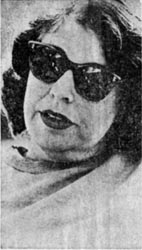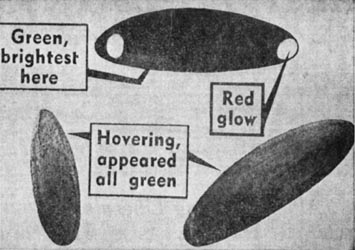In the reign of Thutmose III, an Egyptian scribe
recorded that circles of fire had been seen in the sky.
First there was only one of them, but
as the days went on there were many more. The people were terrified. They
cried out and crawled upon their bellies.
Thirty - four hundred years later,
June 24, 1947, Kenneth Arnold, a Boise, Idaho, businessman, flying his plane
on a business trip, sighted what appeared to be a string of strange aircraft
flying over Mount Rainier in Washington. He estimated that they were 20 to 25
miles away were 45 to 50 feet long and flew at 1,700 miles an hour. Describing
them to newspapermen, he said that they flew with a strange motion, “like a
saucer would if you skipped it across water.”
A CATCHY NAME
The newsmen, always alert to a catchy
phrase, called them flying saucers, although, it appears now, Arnold was not
the first man to so describe them.
On Sept. 24, 1878, the Denison Daily
News, of Denison, Tex., reported that John Martin, a farmer who lived a few
miles south of Denison, had seen a dark disc flying across the sky at a high
rate of speed and had described it as saucer - shaped.
In 1878, however, the description phrase did not catch on. Arnold’s
description, carried on the press wires and published in hundreds of papers,
did. And, with this report was born the flying saucer controversy.
IMPACT RECENT
Many strange sights had been seen in the sky, centuries before Arnold saw his
saucers. But they made little impact on public consciousness until the magic
phrase was written to grip the public imagination.
Today we no longer call them flying saucers. Now they are called Unidentified
Flying Objects, shortened to UFOs.
It just happened that the ones Arnold saw were disc-shaped. Actually, they
come in several shapes and sizes, Mostly they are discs, wheels, spheres
or cigar-shaped. Usually they are silent, although at times they may make a
noise. They may be shiny objects or appear to be lighted; at other times they
pulse, changing in brightness, or come equipped with flashing lights, which
are usually red or green.
GOOD DESCRIPTIONS
We have many good descriptions of them, some of these from highly reliable
witnesses.
The Egyptian scribe, reporting on his circles of fire, likewise gave a good
description Like a good scientist, which he certainly was not, he pegged the
time of the sighting: “in the year 22, of the third month of the winter, sixth
hour of the day.” The bodies of the objects were one rod in diameter. They gave
off a foul odor and “had no voice." They were brighter than the sun.
Thutmose III, a king of the 18th Dynasty, probably ruled from about 1501 BC
until 1443 BC. Thus, the tattered papyrus which carries the scribe’s story may
be the oldest record of what we call a UFO.
EARLY SIGHTINGS
Jacques Vallee, a mathematician and astronomer, who in 1965 wrote one of the
most thoughtful books to date on the UFO situation, through the years has
collected evidence of early sightings of objects which might be the equivalent
of today’s UFOs. He has on file more than 300 sightings prior to the 20th
century.
In his book, Anatomy of a Phenomenon, he writes that it is his belief that a
search through documents, letters and other papers in the libraries of
churches, castles and monasteries throughout Western Europe would reveal many
UFO reports which have been hidden away for centuries. He feels that in any
serious study of the situation these older sightings must be taken into
consideration.
CAVEMAN DAYS
UFOs did not suddenly come into being on the day that Arnold saw his discs
above Mount Rainier. They have been around for a long, long time. It is not
too great a flight of fancy to imagine that brutish, prehistoric men might
have cowered in fright, like the Egyptians, at things seen in the sky.
More recently, but prior to the Arnold sighting, the UFOs were common during
the last years of the Second World War. In the winter of 1944, Allied airmen
began reporting the sighting of pulsating red fireballs. In many instances,
these balls flew alongside the planes, sometimes for a good part of a mission.
The fliers called them “foo fighters,” and for a time feared that they were a
new kind of enemy weapon.
OTHERS SAW THEM
After the war was concluded, it was learned that German and Japanese pilots,
seeing the same phenomena, at first had feared that they were some sort of new
Allied weapon.
In the summer of 1946, hundreds of “ghost rockets” flew across Scandinavian
skies. The belief generally seemed to be that they were test rockets being
flown by the Russians, although the very number of them should have been a
tipoff that rocket testing was not involved. The fact that the Russians by
that time held the German rocket and missile development centre at Peenemunde
probably lent some credence to the belief.
But to go back a ways.
The prophet Ezekiel, as related in the Old Testament, in 593 BC, saw what
might have been a UFO: “And I looked, and, behold, a whirlwind came out of the
north, a great cloud, and a fire infolding itself, and a brightness was about
it, and out of the midst thereof as the color of amber, out of the midst of
the fire.”
DESCRIBES IT
Ezekiel goes on to describe what he had seen in considerably more detail. The
description, couched in the language of a man who knew no science and little
technology, nevertheless is objective.
Creatures in the object spoke to him, and he was taken aboard and transported
to the Tel Abib mountains, where he remained “astonished” for seven days.
In the medieval years, so many strange objects flew over Western Europe that
Charlemagne and other kings thought it prudent and necessary to prescribe
penalties against creatures that travelled on aerial ships.
On the night of March 6, 1716, Edmond Halley, the British astronomer for whom
Halley’s comet is named, saw an object in the sky which glowed so brightly
that he could read a printed page by its lights. It stayed in the sky for more
than two hours.
MANY EXAMPLES
These examples could go on and on. A book could be written about the pre-1947,
pre- Arnold sightings.
The significant thing about all these sightings, however, would seem to be the
various interpretations which have been placed upon them, the interpretations
matching in each instance the temper and the intellectual bent of the times in
which they were sighted.
In the Middle Ages and earlier (and in some cases long after), they were
regarded in a religious light and were thought of as visions or divine
manifestations. They were “signs in the sky.”
In the days of the Second World War, the “ghost rockets” and the “foo
fighters” were thought of as implements of war.
TODAY’S THINKING
But today, in the space age, they tend to be thought of as spacecraft,
controlled by intelligences, perhaps from solar systems circling other stars
many light years distant.
Out of this present–day concept arises the great controversy that today
revolves about the UFOs.
One large school of thought is convinced that the UFOs in fact are spaceships
and that the earth for centuries has been under surveillance and study by the
creatures which operate them.
Another school of thought, perhaps as large, believes that UFOs are no more
than natural phenomena, which can be explained in terms of happenings on the
earth or in its atmosphere.
SOME OPEN MINDS
Between these schools of thought stand those people who have tried to keep an
open mind and who, in consequence, are greatly puzzled and sometimes
disturbed, unable to arrive at any decision or belief, one way or the other.
This is understandable, for there is no real proof to which either side in the
controversy can point. Photos and motion pictures have been taken of UFOs and
all of them have been disputed. So far as is known, no scrap of material has
ever been recovered from a UFO which would serve as a basis for making a solid
scientific judgment.
The U.S. Air Force has the official responsibility for the investigation of
the UFOs. The air force position is that no evidence has been found that the
UFOs are anything other than natural phenomena mistakenly reported.
Led by the National Investigations Committee on Aerial Phenomena (NICAP) the
“believers” charge that the air force knows far more than it has released,
that it, in effect, has clamped down a censorship.
Two theories exist on this matter.
Either the air force has obtained significant proof of UFO reality and,
fearing a public panic, is withholding the facts until the public can be
psychologically prepared to accept them, or the withholding of information has
nothing to do with a special or exclusive knowledge of the subject but stems
more or less from governmental red tape, lack of continuity of the UFO
project, or differences of opinion within the air force.
The air force denies this. It declares it is concealing nothing.
Thus at the moment, it all boils down to a matter of belief.
The man who wants to make an honest decision on what he should believe faces a
quandary. The lack of solid proof that the UFOs are anything other than the
manifestations of natural phenomena impels him toward a negative belief.
The stature of many of the people who have seen UFOs, honest citizens who are
in a position to know what they are talking about and are convinced that the
things they saw are not natural phenomena, inclines him to think that he must
give a large measure of credence to what they report.




 HOMEPAGE
HOMEPAGE COLLISON
COLLECTION
COLLISON
COLLECTION